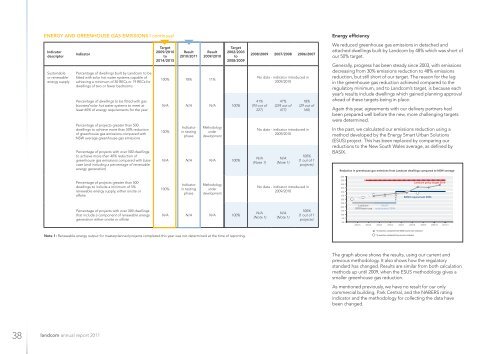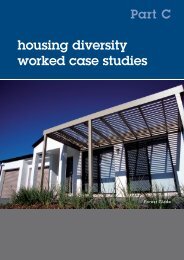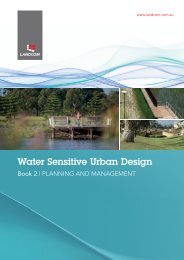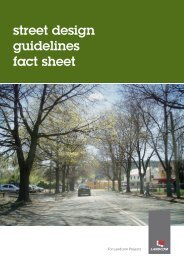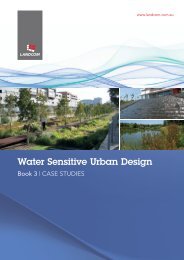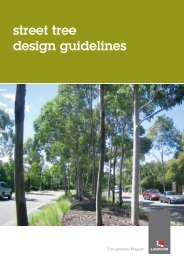to download the PDF - Landcom - NSW Government
to download the PDF - Landcom - NSW Government
to download the PDF - Landcom - NSW Government
Create successful ePaper yourself
Turn your PDF publications into a flip-book with our unique Google optimized e-Paper software.
ENERGY AND GREENHOUSE GAS EMISSIONS | continued<br />
Indica<strong>to</strong>r<br />
descrip<strong>to</strong>r<br />
Sustainable<br />
or renewable<br />
energy supply<br />
Indica<strong>to</strong>r<br />
Percentage of dwellings built by <strong>Landcom</strong> <strong>to</strong> be<br />
fitted with solar hot water systems capable of<br />
achieving a minimum of 30 RECs or 19 RECs for<br />
dwellings of two or fewer bedrooms<br />
Percentage of dwellings <strong>to</strong> be fitted with gas<br />
boosted solar hot water systems <strong>to</strong> meet at<br />
least 60% of energy requirements for <strong>the</strong> year<br />
Percentage of projects greater than 500<br />
dwellings <strong>to</strong> achieve more than 50% reduction<br />
of greenhouse gas emissions compared with<br />
<strong>NSW</strong> average greenhouse gas emissions<br />
Percentage of projects with over 500 dwellings<br />
<strong>to</strong> achieve more than 40% reduction of<br />
greenhouse gas emissions compared with base<br />
case (and including a percentage of renewable<br />
energy generation)<br />
Target<br />
2009/2010<br />
<strong>to</strong><br />
2014/2015<br />
Result<br />
2010/2011<br />
Result<br />
2009/2010<br />
100% 18% 11%<br />
Target<br />
2002/2003<br />
<strong>to</strong><br />
2008/2009<br />
N/A N/A N/A 100%<br />
100%<br />
Indica<strong>to</strong>r<br />
in testing<br />
phase<br />
Methodology<br />
under<br />
development<br />
N/A N/A N/A 100%<br />
2008/2009 2007/2008 2006/2007<br />
No data - indica<strong>to</strong>r introduced in<br />
2009/2010<br />
41%<br />
(93 out of<br />
227)<br />
47%<br />
(224 out of<br />
477)<br />
18%<br />
(29 out of<br />
160)<br />
No data - indica<strong>to</strong>r introduced in<br />
2009/2010<br />
N/A<br />
(Note 1)<br />
N/A<br />
(Note 1)<br />
100%<br />
(1 out of 1<br />
projects)<br />
Energy efficiency<br />
We reduced greenhouse gas emissions in detached and<br />
attached dwellings built by <strong>Landcom</strong> by 48% which was short of<br />
our 50% target.<br />
Generally, progress has been steady since 2003, with emissions<br />
decreasing from 30% emissions reduction <strong>to</strong> 48% emissions<br />
reduction, but still short of our target. The reason for <strong>the</strong> lag<br />
in <strong>the</strong> greenhouse gas reduction achieved compared <strong>to</strong> <strong>the</strong><br />
regula<strong>to</strong>ry minimum, and <strong>to</strong> <strong>Landcom</strong>’s target, is because each<br />
year’s results include dwellings which gained planning approval<br />
ahead of <strong>the</strong>se targets being in place.<br />
Again this year, agreements with our delivery partners had<br />
been prepared well before <strong>the</strong> new, more challenging targets<br />
were determined.<br />
In <strong>the</strong> past, we calculated our emissions reduction using a<br />
method developed by <strong>the</strong> Energy Smart Urban Solutions<br />
(ESUS) project. This has been replaced by comparing our<br />
reductions <strong>to</strong> <strong>the</strong> New South Wales average, as defined by<br />
BASIX.<br />
Reduction in greenhouse gas emissions from <strong>Landcom</strong> dwellings compared <strong>to</strong> <strong>NSW</strong> average<br />
60%<br />
Percentage of projects greater than 500<br />
dwellings <strong>to</strong> include a minimum of 5%<br />
renewable energy supply, ei<strong>the</strong>r onsite or<br />
offsite<br />
Percentage of projects with over 500 dwellings<br />
that include a component of renewable energy<br />
generation ei<strong>the</strong>r onsite or offsite<br />
100%<br />
Indica<strong>to</strong>r<br />
in testing<br />
phase<br />
Methodology<br />
under<br />
development<br />
N/A N/A N/A 100%<br />
No data - indica<strong>to</strong>r introduced in<br />
2009/2010<br />
N/A<br />
(Note 1)<br />
N/A<br />
(Note 1)<br />
100%<br />
(1 out of 1<br />
projects)<br />
55%<br />
50%<br />
45%<br />
40%<br />
35%<br />
30%<br />
25%<br />
20%<br />
15%<br />
10%<br />
5%<br />
0%<br />
GRAPH 5 GOES HERE<br />
<strong>Landcom</strong> policy target 2010<br />
BASIX requirement 2006<br />
<strong>Landcom</strong><br />
BASIX<br />
2003 base case requirement 2004<br />
2004/5 2005/6 2002/3 2003/4<br />
2006/7 2007/8 2008/9 2009/10 2010/11<br />
Note 1: Renewable energy output for masterplanned projects completed this year was not determined at <strong>the</strong> time of reporting.<br />
% reduction calculated from BASIX scores (new indica<strong>to</strong>r)<br />
% reduction calculated from previous indica<strong>to</strong>r<br />
The graph above shows <strong>the</strong> results, using our current and<br />
previous methodology. It also shows how <strong>the</strong> regula<strong>to</strong>ry<br />
standard has changed. Results are similar from both calculation<br />
methods up until 2009, when <strong>the</strong> ESUS methodology gives a<br />
smaller greenhouse gas reduction.<br />
As mentioned previously, we have no result for our only<br />
commercial building, Park Central, and <strong>the</strong> NABERS rating<br />
indica<strong>to</strong>r and <strong>the</strong> methodology for collecting <strong>the</strong> data have<br />
been changed.<br />
38<br />
landcom annual report 2011


